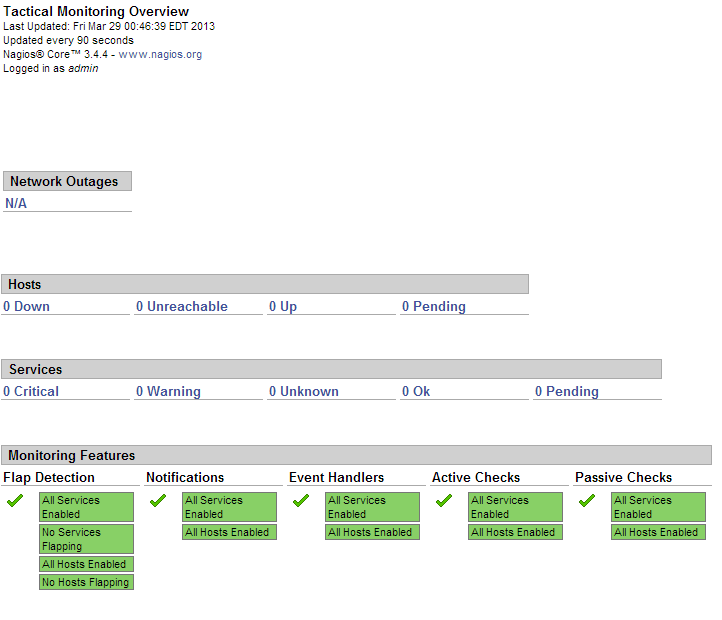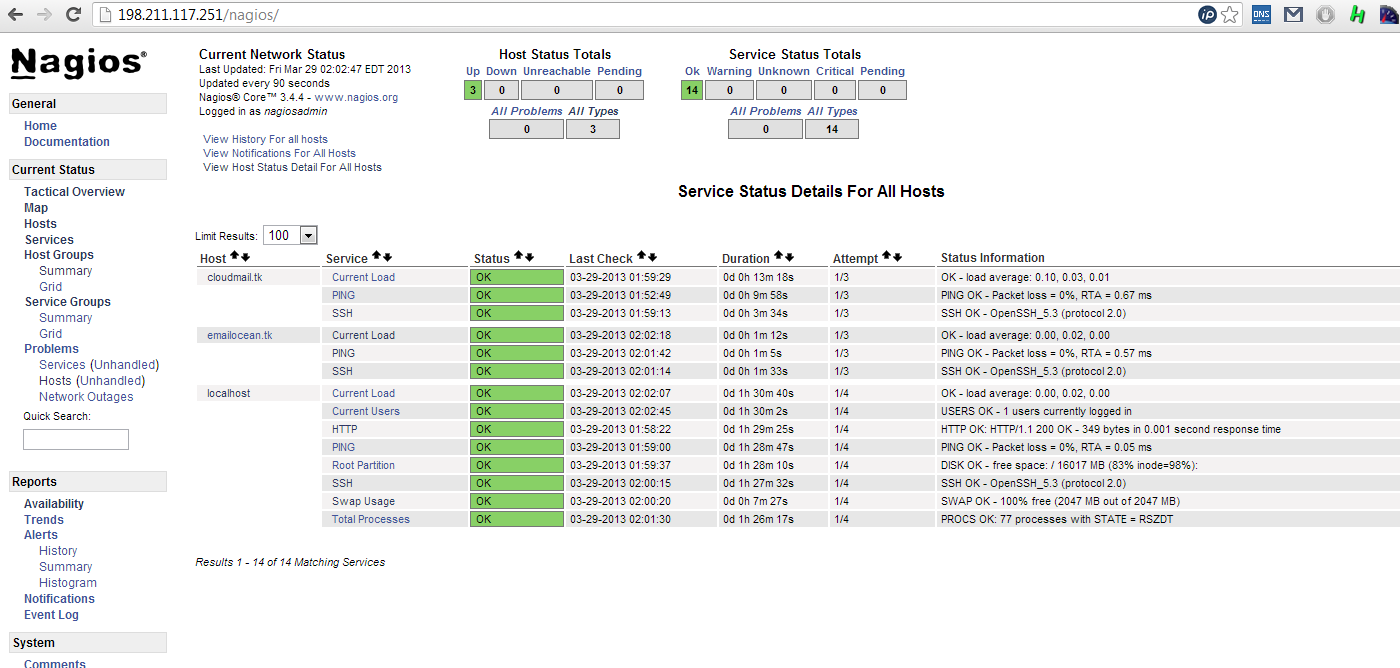| Home » Categories » Multiple Categories |
How To Install Nagios On CentOS 6 |
|
Article Number: 275 | Rating: Unrated | Last Updated: Tue, Sep 23, 2025 at 11:04 PM
|
Step 1 - Install Packages on Monitoring Serverrpm -Uvh http://dl.fedoraproject.org/pub/epel/6/x86_64/epel-release-6-8.noarch.rpm rpm -Uvh http://rpms.famillecollet.com/enterprise/remi-release-6.rpm yum -y install nagios nagios-plugins-all nagios-plugins-nrpe nrpe php httpd chkconfig httpd on && chkconfig nagios on service httpd start && service nagios start We should also enable SWAP memory, at least 2GB: dd if=/dev/zero of=/swap bs=1024 count=2097152 mkswap /swap && chown root. /swap && chmod 0600 /swap && swapon /swap echo /swap swap swap defaults 0 0 >> /etc/fstab echo vm.swappiness = 0 >> /etc/sysctl.conf && sysctl -p Step 2 - Set Password ProtectionSet Nagios Admin Panel Password: htpasswd -c /etc/nagios/passwd nagiosadmin  Make sure to keep this username as "nagiosadmin" - otherwise you would have to change /etc/nagios/cgi.cfg and redefine authorized admin. Now you can navigate over to your host's IP address http://IP/nagios and login. You will be prompted for password you set in Step 2:  This is what the Nagios admin panel looks like:  Since this is a fresh installation, we don't have any hosts currently being monitored.  Now we should add our hosts that will be monitored by Nagios. For example, we will use cloudmail.tk (198.211.107.218) and emailocean.tk (198.211.112.99). From public ports, we can monitor ping, any open ports such as webserver, e-mail server, etc. For internal services that are listening on localhost, such as MySQL, memcached, system services, we will need to use NRPE. Step 4 - Install NRPE on Clientsrpm -Uvh http://dl.fedoraproject.org/pub/epel/6/x86_64/epel-release-6-8.noarch.rpm rpm -Uvh http://rpms.famillecollet.com/enterprise/remi-release-6.rpm yum -y install nagios nagios-plugins-all nrpe chkconfig nrpe on This next step is where you get to specify any manual commands that Monitoring server can send via NRPE to these client hosts. Make sure to change allowed_hosts to your own values. Edit /etc/nagios/nrpe.cfg log_facility=daemon pid_file=/var/run/nrpe/nrpe.pid server_port=5666 nrpe_user=nrpe nrpe_group=nrpe allowed_hosts=198.211.117.251 dont_blame_nrpe=1 debug=0 command_timeout=60 connection_timeout=300 include_dir=/etc/nrpe.d/ command[check_users]=/usr/lib64/nagios/plugins/check_users -w 5 -c 10 command[check_load]=/usr/lib64/nagios/plugins/check_load -w 15,10,5 -c 30,25,20 command[check_disk]=/usr/lib64/nagios/plugins/check_disk -w 20% -c 10% -p /dev/vda command[check_zombie_procs]=/usr/lib64/nagios/plugins/check_procs -w 5 -c 10 -s Z command[check_total_procs]=/usr/lib64/nagios/plugins/check_procs -w 150 -c 200 command[check_procs]=/usr/lib64/nagios/plugins/check_procs -w $ARG1$ -c $ARG2$ -s $ARG3$ Note: In check_disk above, the partition being checked is /dev/vda - make sure your host has the same partition by running df -h / You can also modify when to trigger warnings or critical alerts - above configuration sets Warning at 20% free disk space remaining, and Critical alert at 10% free space remaining. We should also setup firewall rules to allow connections from our Monitoring server to those clients and drop everyone else: iptables -N NRPE iptables -I INPUT -s 0/0 -p tcp --dport 5666 -j NRPE iptables -I NRPE -s 198.211.117.251 -j ACCEPT iptables -A NRPE -s 0/0 -j DROP /etc/init.d/iptables save Now you can start NRPE on all of your client hosts: service nrpe start Step 5 - Add Server Configurations on Monitoring ServerBack on our Monitoring server, we will have to create config files for each of our client servers: echo "cfg_dir=/etc/nagios/servers" >> /etc/nagios/nagios.cfg cd /etc/nagios/servers touch cloudmail.tk.cfg touch emailocean.tk.cfg Edit each client's configuration file and define which services you would like monitored. nano /etc/nagios/servers/cloudmail.tk.cfg Add the following lines: define host {
use linux-server
host_name cloudmail.tk
alias cloudmail.tk
address 198.211.107.218
}
define service {
use generic-service
host_name cloudmail.tk
service_description PING
check_command check_ping!100.0,20%!500.0,60%
}
define service {
use generic-service
host_name cloudmail.tk
service_description SSH
check_command check_ssh
notifications_enabled 0
}
define service {
use generic-service
host_name cloudmail.tk
service_description Current Load
check_command check_local_load!5.0,4.0,3.0!10.0,6.0,4.0
}You can add more services to be monitored as desired. Same configuration should be added for second client, emailocean.tk, with different IP address and host_name:This is a snippet of /etc/nagios/servers/emailocean.tk.cfg: define host {
use linux-server
host_name emailocean.tk
alias emailocean.tk
address 198.211.112.99
}
...You can add additional clients to be monitored as /etc/nagios/servers/AnotherHostName.cfg Finally, after you are done adding all the client configurations, you should set folder permissions correctly and restart Nagios on your Monitoring Server: chown -R nagios. /etc/nagios service nagios restart Step 6 - Monitor Hosts in NagiosNavigate over to your Monitoring Server's IP address http://IP/nagios and enter password set in Step 2. Now you should be able to see all the hosts and services:  And you are all done! |
Attachments

There are no attachments for this article.
|
How To Install Wordpress with nginx on CentOS 6
Viewed 9536 times since Sat, Jan 4, 2014
How To Install Ruby on Rails on CentOS 6
Viewed 3453 times since Tue, Dec 31, 2013
Installing and Using the Vim Text Editor on a Cloud Server
Viewed 2947 times since Fri, Dec 27, 2013
How To Copy Files With Rsync Over SSH
Viewed 6864 times since Fri, Dec 27, 2013
How To Install And Run A Node.js App On Centos 6.4 64bit
Viewed 10795 times since Sun, Dec 29, 2013
How To Use Top, Netstat, Du, & Other Tools to Monitor Server Resources
Viewed 7223 times since Sat, Jan 4, 2014
How To Work with the ZeroMQ Messaging Library
Viewed 8649 times since Sat, Jan 4, 2014
How To Set Up vsftpd on Ubuntu 12.04
Viewed 2555 times since Thu, Dec 26, 2013
How To Setup a Rails 4 App With Apache and Passenger on CentOS 6
Viewed 4029 times since Thu, Dec 19, 2013
The Basics of Using the Sed Stream Editor to Manipulate Text in Linux
Viewed 6856 times since Fri, Dec 27, 2013
|
 Subscribe to Article
Subscribe to Article Print Article
Print Article-
 Email Article to Friend
Email Article to Friend
 Export to PDF
Export to PDF Export to MS Word
Export to MS Word Tweet This Article
Tweet This Article Digg It
Digg It Stumble Upon
Stumble Upon Del.icio.us
Del.icio.us
